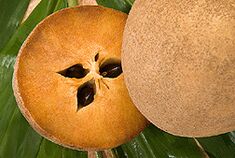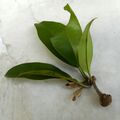Biology:Manilkara zapota
| Manilkara zapota | |
|---|---|

| |
| Scientific classification | |
| Kingdom: | Plantae |
| Clade: | Tracheophytes |
| Clade: | Angiosperms |
| Clade: | Eudicots |
| Clade: | Asterids |
| Order: | Ericales |
| Family: | Sapotaceae |
| Genus: | Manilkara |
| Species: | M. zapota
|
| Binomial name | |
| Manilkara zapota (L.) P.Royen
| |
| Synonyms | |
|
See text | |
 Fruit, cross-section | |
| Nutritional value per 100 g (3.5 oz) | |
|---|---|
| Energy | 347 kJ (83 kcal) |
19.96 g | |
| Dietary fiber | 5.3 g |
1.1 g | |
0.44 g | |
| Vitamins | Quantity %DV† |
| Riboflavin (B2) | 2% 0.02 mg |
| Niacin (B3) | 1% 0.2 mg |
| Pantothenic acid (B5) | 5% 0.252 mg |
| Vitamin B6 | 3% 0.037 mg |
| Folate (B9) | 4% 14 μg |
| Vitamin C | 18% 14.7 mg |
| Minerals | Quantity %DV† |
| Calcium | 2% 21 mg |
| Iron | 6% 0.8 mg |
| Magnesium | 3% 12 mg |
| Phosphorus | 2% 12 mg |
| Potassium | 4% 193 mg |
| Sodium | 1% 12 mg |
| Zinc | 1% 0.1 mg |
| |
| †Percentages are roughly approximated using US recommendations for adults. Source: USDA Nutrient Database | |
Manilkara zapota, commonly known as sapodilla ([ˌsapoˈðiʝa]),[2] sapote, chicozapote, chicoo, chicle, naseberry, or nispero, soapapple among other names,[3][4] is an evergreen tree native to southern Mexico and Central America. An example natural occurrence is in coastal Yucatán in the Petenes mangroves ecoregion, where it is a subdominant plant species.[5] It was introduced to the Philippines during Spanish colonization. It is grown in large quantities in Mexico and in tropical Asia including India, Pakistan, Thailand, Malaysia, Cambodia, Indonesia, Vietnam, Bangladesh, as well as the Caribbean.
The specific epithet zapota is from the Spanish zapote [saˈpote], which ultimately derives from the Nahuatl word tzapotl.
Description
thumb|left|Sapodilla tree Sapodilla can live up to one hundred years.[6][7] It can grow to more than 30 m (98 ft) tall with a trunk diameter of up to 1.5 m (5 ft). The average height of cultivated specimens, however, is usually between 9 and 15 m (30 and 49 ft) with a trunk diameter not exceeding 50 cm (20 in).[8] It is wind-resistant and the bark is rich in a white, gummy latex called chicle. The ornamental leaves are medium green and glossy. They are alternate, elliptic to ovate, 7–15 cm (3–6 in) long, with an entire margin. The white flowers are inconspicuous and bell-like, with a six-lobed corolla. An unripe fruit has a firm outer skin and when picked, releases white chicle from its stem. A fully ripened fruit has saggy skin and does not release chicle when picked.
The fruit is a large berry, 4–8 cm (2–3 in) in diameter.[9][10] Inside, its flesh ranges from a pale yellow to an earthy brown color with a grainy texture akin to that of a well-ripened pear. Each fruit contains one to six seeds.[10] The seeds are hard, glossy, and black, resembling beans, with a hook at one end that can catch in the throat if swallowed.
The fruit has an exceptionally sweet, malty flavor. The unripe fruit is hard to the touch and contains high amounts of saponin, which has astringent properties similar to tannin, drying out the mouth.
The trees can survive only in warm, typically tropical environments (although it has low tolerance to drought and heat in its early years),[11] dying easily if the temperature drops below freezing. From germination, the sapodilla tree will usually take anywhere from five to eight years to bear fruit. The sapodilla trees yield fruit twice a year, though flowering may continue year round.[12]
Other names
thumb|right|Sapodilla fruits being sold on a street in Guntur, India Most of the common names of Manilkara zapota like "sapodilla" and "chicozapote" come from Spanish meaning "little sapote".[4] Other common names in English for Manilkara zapota include bully tree, soapapple tree sawo, and marmalade plum.[13]
Biological studies
Compounds extracted from the leaves showed anti-diabetic, antioxidant and hypocholesterolemic (cholesterol-lowering) effects in rats.[14]
Acetone extracts of the seeds exhibited in vitro antibacterial effects against strains of Pseudomonas oleovorans and Vibrio cholerae.[15]
Synonyms
Synonyms of this species include:[16]
Uses
The fruit is edible and a favorite in the tropical Americas.[17] Chicle from the bark is used to make chewing gum.
See also
- Sapote
References
- ↑ Martínez Salas, E.; Samain, M.; Oldfield, S. (2021). "Manilkara zapota". IUCN Red List of Threatened Species 2021: e.T61964429A61964470. https://www.iucnredlist.org/species/61964429/61964470. Retrieved 23 June 2022.
- ↑ "Manilkara zapota". Natural Resources Conservation Service PLANTS Database. USDA. https://plants.usda.gov/core/profile?symbol=MAZA.
- ↑ {{citation | mode = cs1 | title = Manilkara zapota | work = Germplasm Resources Information Network (GRIN) | url = | publisher = [[Organization:Agricultural Research ServAgricultural Research Service (ARS), United States Department of Agriculture (USDA) | access-date = 23 June 2022 }}
- ↑ 4.0 4.1 Small, Ernest (23 August 2011). Top 100 Exotic Food Plants. CRC Press. p. 515. ISBN 9781439856888.
- ↑ World Wildlife Fund. eds. Mark McGinley, C.Michael Hogan & C. Cleveland. 2010. Petenes mangroves. Encyclopedia of Earth. National Council for Science and the Environment. Washington DC
- ↑ Horticulture: Crop Plantation Guidence - The Sapota (Chickoo). India Agro. Retrieved 8 August, 2023.
- ↑ Introduction to Sapota. Agri Farming. Retrieved 14 August, 2023.
- ↑ Manilkara zapota Sapotaceae (L.) van Royen, Orwa C, Mutua A, Kindt R, Jamnadass R, Simons A. 2009. Agroforestree Database:a tree reference and selection guide version 4.0 (http://www.worldagroforestry.org/af/treedb/)
- ↑ Flora of North America, 8, http://www.efloras.org/florataxon.aspx?flora_id=1&taxon_id=200017540
- ↑ 10.0 10.1 Harris, Kate (2009). Trees of Belize. Belize: Bay Cedar Publishing. pp. 94–95. ISBN 9780992758202.
- ↑ Growing Sapodilla: Manilkara zapota. Garden Oracle. Retrieved 8 August, 2023. "Heat tolerant: These trees have difficulty when young, over 90°F, and when mature, over 105°F. They will need afternoon shade and extra water in these temperatures. Drought tolerant: Yes, after three years."
- ↑ Kute, L.S.; Shete, M.B. (1995). "Sapota (Sapodilla)". Handbook of Fruit Science and Technology. CRC Press. pp. 475–476. doi:10.1201/9781482273458-31. ISBN 9780429152733. https://doi.org/10.1201/9781482273458-31. Retrieved 24 August 2022.
- ↑ "Manilkara zapota". European and Mediterranean Plant Protection Organization (EPPO). https://gd.eppo.int/taxon/MNKZA.
- ↑ "Chemical and biological study of Manilkara zapota (L.) Van Royen leaves (Sapotaceae) cultivated in Egypt.". Pharmacognosy Research 4 (2): 85–91. 2012. doi:10.4103/0974-8490.94723. PMID 22518080.
- ↑ "In vitro antibacterial activity in seed extracts of Manilkara zapota, Anona squamosa, and Tamarindus indica.". Biol. Res. 43 (2): 165–8. 2010. doi:10.4067/S0716-97602010000200003. PMID 21031260.
- ↑ The Plant List: A Working List of All Plant Species, http://www.theplantlist.org/tpl1.1/record/kew-120271, retrieved 18 October 2015
- ↑ Hargreaves, Dorothy; Hargreaves, Bob (1964). Tropical Trees of Hawaii. Kailua, Hawaii: Hargreaves. p. 14.
External links
Wikidata ☰ Q14959 entry
 |









